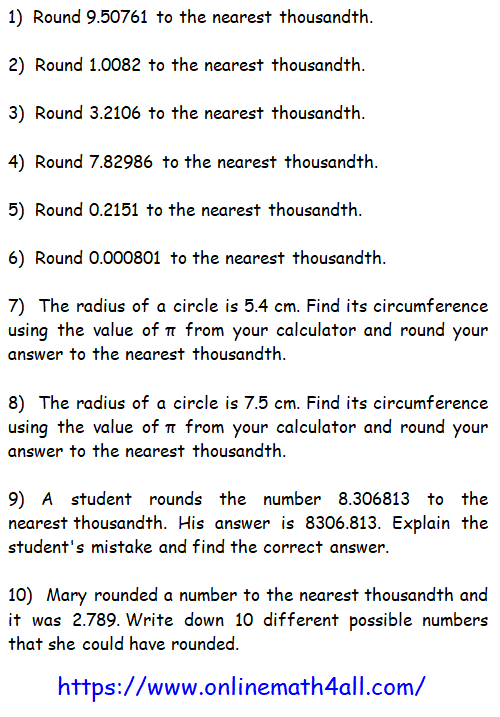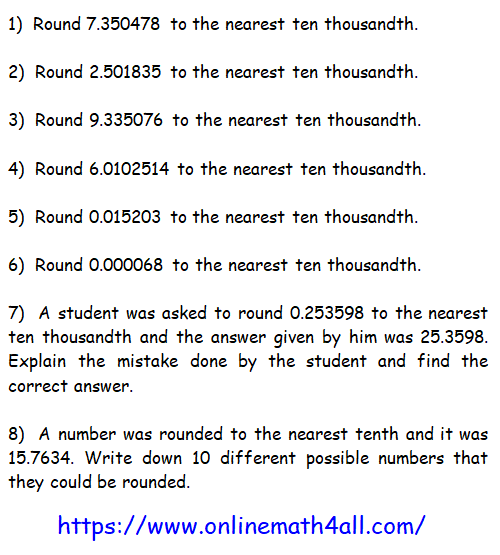Understanding how to round to the nearest thousandth is an essential skill in mathematics and various real-life applications. Whether you're working with decimals, measurements, or financial calculations, mastering this concept ensures precision and accuracy. This article will delve into the intricacies of rounding to the nearest thousandth, providing practical examples and step-by-step explanations to help you grasp the concept fully.
Rounding numbers is a fundamental mathematical operation that simplifies complex numbers while maintaining their approximate value. When dealing with decimals, rounding to the nearest thousandth is particularly useful, especially in fields like engineering, finance, and science, where precision is paramount.
This guide aims to provide a detailed explanation of rounding to the nearest thousandth, complete with examples, tips, and practical applications. By the end of this article, you'll have a solid understanding of the process and how it applies to real-world scenarios.
Table of Contents
What Does "Nearest Thousandth" Mean?
Rules for Rounding to the Nearest Thousandth
Round to the Nearest Thousandth Examples
Practical Applications of Rounding
Comparison with Other Rounding Methods
What is Rounding?
Rounding is a mathematical process used to simplify numbers while keeping their value close to the original. It involves replacing a number with another value that is easier to work with, especially when dealing with long decimals or large numbers. Rounding is commonly used in everyday life, from calculating tips at a restaurant to estimating costs for a project.
The purpose of rounding is to make calculations more manageable without losing significant accuracy. For example, instead of working with a number like 3.14159265359, you can round it to 3.142, which is much easier to handle in most situations.
What Does "Nearest Thousandth" Mean?
The term "nearest thousandth" refers to the third digit after the decimal point. When you round a number to the nearest thousandth, you are essentially focusing on the thousandths place and adjusting it based on the digit immediately following it (the ten-thousandths place). For instance, in the number 5.6784, the digit 8 represents the thousandths place, and the digit 4 represents the ten-thousandths place.
Understanding Decimal Places
Before diving into rounding, it's essential to understand decimal places:
- Tenths place: The first digit after the decimal point.
- Hundredths place: The second digit after the decimal point.
- Thousandths place: The third digit after the decimal point.
Rules for Rounding to the Nearest Thousandth
Rounding to the nearest thousandth follows a set of straightforward rules:
- Identify the digit in the thousandths place.
- Look at the digit immediately following it (the ten-thousandths place).
Apply the following conditions:
- If the ten-thousandths digit is 5 or greater, round up the thousandths digit by 1.
- If the ten-thousandths digit is less than 5, leave the thousandths digit unchanged.
For example, rounding 4.5678 to the nearest thousandth:
- The thousandths digit is 7.
- The ten-thousandths digit is 8, which is greater than 5.
- Therefore, round up the thousandths digit to 8, resulting in 4.568.
Round to the Nearest Thousandth Examples
Let's explore some practical examples to solidify your understanding of rounding to the nearest thousandth:
Example 1: Simple Decimal
Rounding 2.3456 to the nearest thousandth:
- The thousandths digit is 5.
- The ten-thousandths digit is 6, which is greater than 5.
- Round up the thousandths digit to 6, resulting in 2.346.
Example 2: Decimal with Repeating Digits
Rounding 7.8999 to the nearest thousandth:
- The thousandths digit is 9.
- The ten-thousandths digit is also 9, which is greater than 5.
- Round up the thousandths digit, causing a carryover to the hundredths place, resulting in 7.900.
Example 3: Decimal Less Than 5
Rounding 1.2342 to the nearest thousandth:
- The thousandths digit is 4.
- The ten-thousandths digit is 2, which is less than 5.
- Leave the thousandths digit unchanged, resulting in 1.234.
Common Mistakes to Avoid
While rounding to the nearest thousandth is relatively simple, there are a few common mistakes to watch out for:
- Ignoring the ten-thousandths place: Always check the digit immediately following the thousandths place to determine whether to round up or down.
- Over-rounding: Avoid rounding multiple times, as it can lead to significant errors in precision.
- Forgetting to carry over: If rounding up causes a carryover, ensure you adjust the preceding digits accordingly.
Practical Applications of Rounding
Rounding to the nearest thousandth has numerous real-world applications, including:
- Scientific Research: Rounding is essential in scientific calculations, where precision is critical but not always necessary to the last decimal place.
- Financial Calculations: In finance, rounding ensures that monetary values are manageable and consistent.
- Engineering: Engineers often use rounding to simplify complex measurements without compromising accuracy.
For instance, in construction, rounding measurements to the nearest thousandth of a meter ensures that materials are cut to the correct size while maintaining structural integrity.
Tricks and Tips for Rounding
Here are some useful tips to make rounding easier:
- Use visual aids like number lines to help visualize the rounding process.
- Practice regularly with different types of numbers to improve your skills.
- Double-check your work to ensure accuracy, especially when dealing with large or complex numbers.
Additionally, understanding the context of the problem can help you determine the appropriate level of precision required.
Comparison with Other Rounding Methods
While rounding to the nearest thousandth is a specific method, there are other rounding techniques you might encounter:
- Rounding to the Nearest Tenth: Focuses on the first digit after the decimal point.
- Rounding to the Nearest Hundredth: Focuses on the second digit after the decimal point.
- Rounding to Whole Numbers: Removes all decimal places, leaving only the integer part.
Each method serves a unique purpose, and choosing the right one depends on the specific requirements of the task at hand.
Tools for Rounding Numbers
Several tools and resources can assist with rounding numbers:
- Online Calculators: Websites like Mathway and Symbolab offer rounding tools that provide instant results.
- Spreadsheet Software: Programs like Microsoft Excel and Google Sheets have built-in functions for rounding numbers.
- Mobile Apps: Numerous apps are available for quick and easy rounding on the go.
These tools can save time and reduce the risk of errors, especially when working with large datasets.
Conclusion and Final Thoughts
Rounding to the nearest thousandth is a valuable skill with applications across various fields. By following the rules and practicing regularly, you can master this concept and apply it confidently in real-world scenarios. Remember to avoid common mistakes and utilize available tools to enhance your accuracy and efficiency.
We encourage you to share your thoughts and experiences in the comments section below. Have you encountered any challenges while rounding numbers? How do you ensure precision in your calculations? Don't forget to explore our other articles for more tips and insights into mathematics and beyond!


